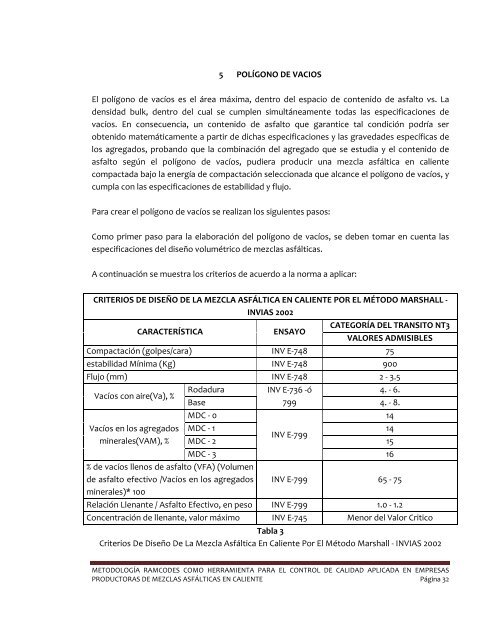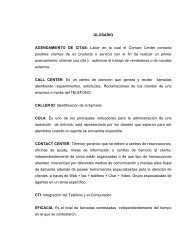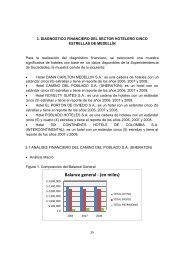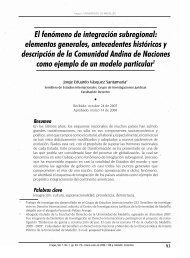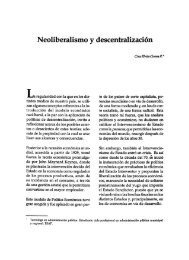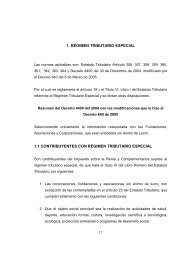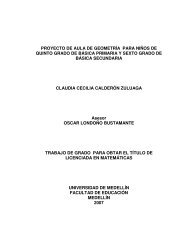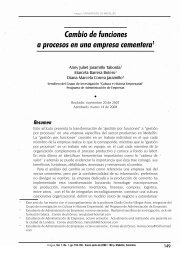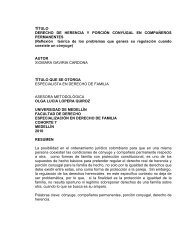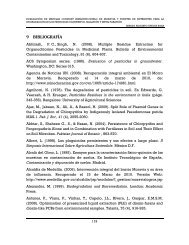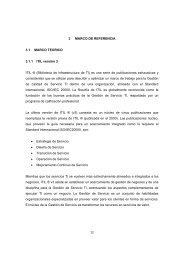5 POLÍGONO DE VACIOS El polígono de vacíos es el área máxima ...
5 POLÍGONO DE VACIOS El polígono de vacíos es el área máxima ...
5 POLÍGONO DE VACIOS El polígono de vacíos es el área máxima ...
Create successful ePaper yourself
Turn your PDF publications into a flip-book with our unique Google optimized e-Paper software.
5 <strong>POLÍGONO</strong> <strong>DE</strong> <strong>VACIOS</strong><br />
<strong>El</strong> <strong>polígono</strong> <strong>de</strong> <strong>vacíos</strong> <strong>es</strong> <strong>el</strong> <strong>área</strong> <strong>máxima</strong>, <strong>de</strong>ntro <strong>de</strong>l <strong>es</strong>pacio <strong>de</strong> contenido <strong>de</strong> asfalto vs. La<br />
<strong>de</strong>nsidad bulk, <strong>de</strong>ntro <strong>de</strong>l cual se cumplen simultáneamente todas las <strong>es</strong>pecificacion<strong>es</strong> <strong>de</strong><br />
<strong>vacíos</strong>. En consecuencia, un contenido <strong>de</strong> asfalto que garantice tal condición podría ser<br />
obtenido matemáticamente a partir <strong>de</strong> dichas <strong>es</strong>pecificacion<strong>es</strong> y las graveda<strong>de</strong>s <strong>es</strong>pecíficas <strong>de</strong><br />
los agregados, probando que la combinación <strong>de</strong>l agregado que se <strong>es</strong>tudia y <strong>el</strong> contenido <strong>de</strong><br />
asfalto según <strong>el</strong> <strong>polígono</strong> <strong>de</strong> <strong>vacíos</strong>, pudiera producir una mezcla asfáltica en caliente<br />
compactada bajo la energía <strong>de</strong> compactación s<strong>el</strong>eccionada que alcance <strong>el</strong> <strong>polígono</strong> <strong>de</strong> <strong>vacíos</strong>, y<br />
cumpla con las <strong>es</strong>pecificacion<strong>es</strong> <strong>de</strong> <strong>es</strong>tabilidad y flujo.<br />
Para crear <strong>el</strong> <strong>polígono</strong> <strong>de</strong> <strong>vacíos</strong> se realizan los siguient<strong>es</strong> pasos:<br />
Como primer paso para la <strong>el</strong>aboración <strong>de</strong>l <strong>polígono</strong> <strong>de</strong> <strong>vacíos</strong>, se <strong>de</strong>ben tomar en cuenta las<br />
<strong>es</strong>pecificacion<strong>es</strong> <strong>de</strong>l diseño volumétrico <strong>de</strong> mezclas asfálticas.<br />
A continuación se mu<strong>es</strong>tra los criterios <strong>de</strong> acuerdo a la norma a aplicar:<br />
CRITERIOS <strong>DE</strong> DISEÑO <strong>DE</strong> LA MEZCLA ASFÁLTICA EN CALIENTE POR EL MÉTODO MARSHALL ‐<br />
INVIAS 2002<br />
CARACTERÍSTICA ENSAYO<br />
CATEGORÍA <strong>DE</strong>L TRANSITO NT3<br />
VALORES ADMISIBLES<br />
Compactación (golp<strong>es</strong>/cara) INV E‐748 75<br />
<strong>es</strong>tabilidad Mínima (Kg) INV E‐748 900<br />
Flujo (mm) INV E‐748 2 ‐ 3.5<br />
Vacíos con aire(Va), %<br />
Rodadura<br />
Base<br />
INV E‐736 ‐ó<br />
799<br />
4. ‐ 6.<br />
4. ‐ 8.<br />
MDC ‐ 0<br />
14<br />
Vacíos en los agregados<br />
mineral<strong>es</strong>(VAM), %<br />
MDC ‐ 1<br />
MDC ‐ 2<br />
INV E‐799<br />
14<br />
15<br />
% <strong>de</strong> <strong>vacíos</strong> llenos <strong>de</strong> asfalto (VFA) (Volumen<br />
<strong>de</strong> asfalto efectivo /Vacíos en los agregados<br />
mineral<strong>es</strong>)* 100<br />
MDC ‐ 3 16<br />
INV E‐799 65 ‐ 75<br />
R<strong>el</strong>ación Llenante / Asfalto Efectivo, en p<strong>es</strong>o INV E‐799 1.0 ‐ 1.2<br />
Concentración <strong>de</strong> llenante, valor máximo INV E‐745<br />
Tabla 3<br />
Menor <strong>de</strong>l Valor Critico<br />
Criterios De Diseño De La Mezcla Asfáltica En Caliente Por <strong>El</strong> Método Marshall ‐ INVIAS 2002<br />
METODOLOGÍA RAMCO<strong>DE</strong>S COMO HERRAMIENTA PARA EL CONTROL <strong>DE</strong> CALIDAD APLICADA EN EMPRESAS<br />
PRODUCTORAS <strong>DE</strong> MEZCLAS ASFÁLTICAS EN CALIENTE Página 32
CRITERIOS <strong>DE</strong> DISEÑO <strong>DE</strong> LA MEZCLA ASFÁLTICA EN CALIENTE POR EL MÉTODO<br />
MARSHALL INVIAS 2007<br />
CARACTERÍSTICA ENSAYO<br />
CATEGORÍA <strong>DE</strong>L TRANSITO NT3<br />
VALORES ADMISIBLES<br />
Compactación (golp<strong>es</strong>/cara) INV E‐748 75<br />
<strong>es</strong>tabilidad Mínima (Kg) INV E‐748 900<br />
Flujo (mm) INV E‐748 2 ‐ 3.5<br />
Vacíos con aire(Va), %<br />
Rodadura<br />
Intermedia<br />
Base<br />
INV E‐736 ‐ó<br />
799<br />
4.‐ 6.<br />
4.‐ 7.<br />
5.‐ 8.<br />
MDC ‐ 0<br />
Mayor o igual a 13<br />
Vacíos en los agregados<br />
mineral<strong>es</strong>(VAM), %<br />
MDC ‐ 1<br />
MDC ‐ 2<br />
INV E‐799<br />
Mayor o igual a 14<br />
Mayor o igual a 15<br />
% <strong>de</strong> <strong>vacíos</strong> llenos <strong>de</strong> asfalto (VFA)<br />
(Volumen <strong>de</strong> asfalto efectivo /Vacíos<br />
en los agregados mineral<strong>es</strong>)* 100<br />
R<strong>el</strong>ación Llenante / Asfalto Efectivo, en<br />
p<strong>es</strong>o<br />
Concentración <strong>de</strong> llenante, valor<br />
máximo<br />
MDC ‐ 3 Mayor o igual a 16<br />
INV E‐799 65 ‐ 75<br />
INV E‐799 0.8 ‐ 1.2<br />
INV E‐745 Valor Critico<br />
Tabla 4<br />
Criterios De Diseño De La Mezcla Asfáltica En Caliente Por <strong>El</strong> Método Marshall INVIAS 2007<br />
CRITERIOS <strong>DE</strong> DISEÑO <strong>DE</strong> LA MEZCLA ASFÁLTICA EN CALIENTE POR EL<br />
MÉTODO MARSHALL ‐ INSTITUTO <strong>DE</strong> ASFALTO<br />
CARACTERÍSTICA<br />
CATEGORÍA <strong>DE</strong>L TRANSITO NT3<br />
VALORES ADMISIBLES<br />
Compactación (golp<strong>es</strong>/cara) 75<br />
<strong>es</strong>tabilidad Mínima (lb) 1800<br />
Flujo (mm) 8 ‐ 14<br />
Vacios con aire(Va), % Rodadura 3 ‐ 5<br />
Vacios en los agregados<br />
mineral<strong>es</strong>(VAM), %<br />
% <strong>de</strong> vacios llenos <strong>de</strong> asfalto (VFA)<br />
(Volumen <strong>de</strong> asfalto efectivo /Vacios<br />
en los agregados mineral<strong>es</strong>)* 100<br />
Ver tabla 6<br />
65 ‐ 75<br />
R<strong>el</strong>ación Llenante / Asfalto Efectivo, 1.0 ‐ 1.2<br />
METODOLOGÍA RAMCO<strong>DE</strong>S COMO HERRAMIENTA PARA EL CONTROL <strong>DE</strong> CALIDAD APLICADA EN EMPRESAS<br />
PRODUCTORAS <strong>DE</strong> MEZCLAS ASFÁLTICAS EN CALIENTE Página 33
CRITERIOS <strong>DE</strong> DISEÑO <strong>DE</strong> LA MEZCLA ASFÁLTICA EN CALIENTE POR EL<br />
MÉTODO MARSHALL ‐ INSTITUTO <strong>DE</strong> ASFALTO<br />
en p<strong>es</strong>o<br />
CARACTERÍSTICA<br />
Concentración <strong>de</strong> llenante, valor<br />
máximo<br />
CATEGORÍA <strong>DE</strong>L TRANSITO NT3<br />
VALORES ADMISIBLES<br />
Menor <strong>de</strong>l Valor Critico<br />
Tabla 5<br />
Criterios De Diseño De La Mezcla Asfáltica En Caliente Por <strong>El</strong> Método Marshall ‐ Instituto De<br />
Asfalto<br />
Nomina Maximum Minimun VAM, percent<br />
Particle size D<strong>es</strong>ign Air Voids, percent<br />
mm in 3 4 5<br />
1.18 No 16 21.5 22.5 23.5<br />
2.36 No 8 19.0 20.0 21.0<br />
4.75 No 4 16.0 17.0 18.0<br />
9.5 3/8 14.0 15.0 16.0<br />
12.5 1/2 13.0 14.0 15.0<br />
19 3/4 12.0 13.0 14.0<br />
25 1.0 11.0 12.0 13.0<br />
37.5 1.5 10.0 11.0 12.0<br />
50 2.0 9.5 10.5 11.5<br />
63 2.5 9.0 10.0 11.0<br />
Tabla 6<br />
Mínimo porcentaje <strong>de</strong> <strong>vacíos</strong> en agregado mineral (VAM)<br />
<strong>es</strong>pecificacion<strong>es</strong> <strong>de</strong>l diseño<br />
volumétrico <strong>de</strong> mezclas asfálticas<br />
% Va: mínimo 3<br />
% Va: Superior. 5<br />
% VAM: mínimo 13<br />
% VAM: Superior. 16<br />
% VFA: mínimo 65<br />
% VFA: Superior. 75<br />
Tabla 7<br />
Especificacion<strong>es</strong> <strong>de</strong>l diseño volumétrico <strong>de</strong> mezclas asfálticas. METODOLOGÍA RAMCO<strong>DE</strong>S.<br />
METODOLOGÍA RAMCO<strong>DE</strong>S COMO HERRAMIENTA PARA EL CONTROL <strong>DE</strong> CALIDAD APLICADA EN EMPRESAS<br />
PRODUCTORAS <strong>DE</strong> MEZCLAS ASFÁLTICAS EN CALIENTE Página 34
Para explicar <strong>el</strong> procedimiento se tomaran los siguient<strong>es</strong> datos<br />
CA: 5.1<br />
Gmm 2.56<br />
Gmb 2.433<br />
Gsb 2.753<br />
Gb 1.018<br />
Tabla 8<br />
Datos <strong>de</strong> ejemplo<br />
Adicionalmente se <strong>de</strong>be contar con los valor<strong>es</strong> <strong>de</strong> Gsb (gravedad <strong>es</strong>pecífica neta <strong>de</strong> la mezcla<br />
<strong>de</strong> agregados) y Gse (gravedad <strong>es</strong>pecífica efectiva <strong>de</strong> la mezcla <strong>de</strong> agregados) para cada<br />
granulometría utilizada.<br />
Si ya <strong>de</strong>l diseño pr<strong>el</strong>iminar se tiene un Gmm, se halla <strong>el</strong> Gse con la siguiente ecuación:<br />
%<br />
<br />
%<br />
<br />
Don<strong>de</strong>:<br />
Gse: Gravedad <strong>es</strong>pecífica efectiva<br />
% CA: Porcentaje <strong>de</strong> asfalto<br />
Gmm: Gravedad <strong>es</strong>pecífica teórica <strong>máxima</strong><br />
Gb: Gravedad <strong>es</strong>pecífica <strong>de</strong>l ligante asfáltico<br />
[Ecuación 4]<br />
Gravedad <strong>es</strong>pecífica teórica <strong>máxima</strong> <strong>de</strong> la mezcla asfáltica en <strong>es</strong>tado su<strong>el</strong>to (Gmm)<br />
Posteriormente se calcula <strong>el</strong> Gmm variando <strong>el</strong> porcentaje <strong>de</strong> asfalto con la ecuación pr<strong>es</strong>entada<br />
a continuación:<br />
<br />
<br />
%<br />
<br />
%<br />
<br />
Don<strong>de</strong>:<br />
Gmm: Gravedad <strong>es</strong>pecífica teórica <strong>máxima</strong><br />
Gb = gravedad <strong>es</strong>pecífica <strong>de</strong>l asfalto<br />
Gse = gravedad efectiva <strong>de</strong>l agregado<br />
%CA = contenido <strong>de</strong> asfalto, %<br />
[Ecuación 5]<br />
METODOLOGÍA RAMCO<strong>DE</strong>S COMO HERRAMIENTA PARA EL CONTROL <strong>DE</strong> CALIDAD APLICADA EN EMPRESAS<br />
PRODUCTORAS <strong>DE</strong> MEZCLAS ASFÁLTICAS EN CALIENTE Página 35
Para nu<strong>es</strong>tro ejemplo se toma la siguiente tabla:<br />
LÍNEAS <strong>DE</strong> VACÍOS <strong>DE</strong> AIRE (VA)<br />
Estimación <strong>de</strong> Gmm<br />
%C.A. Gmm<br />
4 2.609<br />
4.5 2.588<br />
5 2.568<br />
5.5 2.548<br />
6 2.528<br />
Tabla 9<br />
Estimación <strong>de</strong> Gmm<br />
Las líneas <strong>de</strong> <strong>vacíos</strong> <strong>de</strong> aire se <strong>el</strong>aboran utilizando la siguiente ecuación, y tomando en<br />
consi<strong>de</strong>ración los valor<strong>es</strong> <strong>de</strong> Gmm pr<strong>es</strong>entados en la Tabla anterior.<br />
Don<strong>de</strong>:<br />
Gmb: Gravedad <strong>es</strong>pecífica neta<br />
Va: Contenido <strong>de</strong> <strong>vacíos</strong> <strong>de</strong> aire<br />
Gmm: Gravedad <strong>es</strong>pecífica teórica <strong>máxima</strong><br />
<br />
[Ecuación 6]<br />
<br />
Los valor<strong>es</strong> <strong>de</strong> Va que se van a utilizar en <strong>el</strong> cálculo son; 3 y 5% (<strong>es</strong>pecificación), y 0% (saturación<br />
<strong>de</strong> la probeta)<br />
En la tabla a continuación se pr<strong>es</strong>enta los valor<strong>es</strong> <strong>de</strong> Gmb para <strong>vacíos</strong> <strong>de</strong> aire <strong>de</strong> 0, 3 y 5%, para<br />
diferent<strong>es</strong> contenidos <strong>de</strong> asfalto.<br />
Estimación <strong>de</strong> las líneas <strong>de</strong> <strong>vacíos</strong> <strong>de</strong> aire<br />
Porcentaje <strong>de</strong> <strong>vacíos</strong> VA<br />
3 5<br />
%C.A. Gmb %C.A. Gmb<br />
3.50 2.551 3.50 2.499<br />
4.00 2.531 4.00 2.479<br />
4.50 2.51 4.50 2.459<br />
METODOLOGÍA RAMCO<strong>DE</strong>S COMO HERRAMIENTA PARA EL CONTROL <strong>DE</strong> CALIDAD APLICADA EN EMPRESAS<br />
PRODUCTORAS <strong>DE</strong> MEZCLAS ASFÁLTICAS EN CALIENTE Página 36
Estimación <strong>de</strong> las líneas <strong>de</strong> <strong>vacíos</strong> <strong>de</strong> aire<br />
Porcentaje <strong>de</strong> <strong>vacíos</strong> VA<br />
3 5<br />
5.00 2.491 5.00 2.44<br />
5.50 2.472 5.50 2.421<br />
Tabla 10<br />
Estimación <strong>de</strong> las Líneas <strong>de</strong> <strong>vacíos</strong> <strong>de</strong> aire<br />
Con los valor<strong>es</strong> <strong>de</strong> Gmb obtenidos en la Tabla 10 se grafican las primeras líneas <strong>de</strong>l <strong>polígono</strong> <strong>de</strong><br />
<strong>vacíos</strong>.<br />
Gmb (Kg/cm3)<br />
2,6<br />
2,55<br />
2,5<br />
2,45<br />
2,4<br />
2,35<br />
2,3<br />
Ilustración 8. Líneas <strong>de</strong> <strong>vacíos</strong> <strong>de</strong> aire<br />
LÍNEAS <strong>DE</strong> VACÍOS EN EL AGREGADO MINERAL (VAM)<br />
Las líneas <strong>de</strong> <strong>vacíos</strong> en <strong>el</strong> agregado mineral se <strong>el</strong>aboran utilizando la siguiente ecuación. De <strong>es</strong>ta<br />
ecuación se pue<strong>de</strong> observar que <strong>el</strong> valor nec<strong>es</strong>ario para <strong>el</strong> cálculo <strong>es</strong> <strong>el</strong> Gsb<br />
Don<strong>de</strong>:<br />
Gmb: Gravedad <strong>es</strong>pecífica neta<br />
LINEAS <strong>DE</strong> <strong>VACIOS</strong> <strong>DE</strong> AIRE<br />
3,50 4,00 4,50 5,00 5,50<br />
Porcentaje Asfalto (%CA)<br />
<br />
[Ecuación 7]<br />
%<br />
VA 3%<br />
VA 5%<br />
METODOLOGÍA RAMCO<strong>DE</strong>S COMO HERRAMIENTA PARA EL CONTROL <strong>DE</strong> CALIDAD APLICADA EN EMPRESAS<br />
PRODUCTORAS <strong>DE</strong> MEZCLAS ASFÁLTICAS EN CALIENTE Página 37
VAM: Vacíos en <strong>el</strong> agregado mineral<br />
Gsb: Gravedad <strong>es</strong>pecífica neta <strong>de</strong>l agregado.<br />
% CA: Porcentaje <strong>de</strong> asfalto<br />
Los valor<strong>es</strong> <strong>de</strong> VAM que se van a utilizar en <strong>el</strong> cálculo son; 13 y 16% (<strong>es</strong>pecificación).<br />
Estimación <strong>de</strong> las líneas <strong>de</strong> VAM<br />
Vacíos en <strong>el</strong> agregado mineral<br />
13 16<br />
%C.A. Gmb %C.A. Gmb<br />
3.50 2.482 3.50 2.396<br />
4.00 2.495 4.00 2.409<br />
4.50 2.508 4.50 2.421<br />
5.00 2.521 5.00 2.434<br />
5.50 2.535 5.50 2.447<br />
Tabla 11<br />
Estimación <strong>de</strong> las líneas <strong>de</strong> VAM<br />
Con los valor<strong>es</strong> <strong>de</strong> Gmb obtenidos en la Tabla 11 se grafican las primeras líneas <strong>de</strong>l <strong>polígono</strong> <strong>de</strong><br />
<strong>vacíos</strong>.<br />
Gmb (Kg/cm3)<br />
2,56<br />
2,51<br />
2,46<br />
2,41<br />
2,36<br />
2,31<br />
2,26<br />
2,21<br />
2,16<br />
LINEAS VAM<br />
3,50 4,00 4,50 5,00 5,50<br />
Porcentaje Asfalto (% CA)<br />
Ilustración 9. Líneas <strong>de</strong> <strong>vacíos</strong> en agregado mineral<br />
VAM 13%<br />
VAM 16%<br />
METODOLOGÍA RAMCO<strong>DE</strong>S COMO HERRAMIENTA PARA EL CONTROL <strong>DE</strong> CALIDAD APLICADA EN EMPRESAS<br />
PRODUCTORAS <strong>DE</strong> MEZCLAS ASFÁLTICAS EN CALIENTE Página 38
Se graficaron las líneas <strong>de</strong> Va y VAM en forma separada, en la Ilustración 10 se pr<strong>es</strong>entan las<br />
líneas <strong>de</strong> ambos parámetros volumétricos superpu<strong>es</strong>tas.<br />
Gmb (Kg/cm3)<br />
2,6<br />
2,55<br />
2,5<br />
2,45<br />
2,4<br />
2,35<br />
2,3<br />
Ilustración 10. Esbozo <strong>de</strong> <strong>polígono</strong> <strong>de</strong> <strong>vacíos</strong><br />
De la Ilustración 10 se pue<strong>de</strong> observar que las líneas <strong>de</strong> Va y VAM se interceptan, con lo que se<br />
empieza a <strong>es</strong>bozar <strong>el</strong> <strong>área</strong> <strong>de</strong>l <strong>polígono</strong> <strong>de</strong> <strong>vacíos</strong>.<br />
LÍNEAS <strong>DE</strong> VACÍOS LLENADOS CON ASFALTO (VFA)<br />
Las líneas <strong>de</strong> <strong>vacíos</strong> llenados con asfalto se <strong>el</strong>aboran utilizando la siguiente ecuación. De <strong>es</strong>ta<br />
ecuación se pue<strong>de</strong> observar que los valor<strong>es</strong> nec<strong>es</strong>arios para <strong>el</strong> cálculo son <strong>el</strong> Gsb y los valor<strong>es</strong><br />
<strong>de</strong> Gmm pr<strong>es</strong>entados en la Tabla siguiente.<br />
<br />
<br />
<br />
%<br />
<br />
%<br />
<br />
Don<strong>de</strong>:<br />
Gmb: Gravedad <strong>es</strong>pecífica neta<br />
VFA: Vacíos llenos con asfalto<br />
Gmm: Gravedad <strong>es</strong>pecífica teórica <strong>máxima</strong><br />
Gsb: Gravedad <strong>es</strong>pecífica neta <strong>de</strong>l agregado.<br />
% CA: Porcentaje <strong>de</strong> asfalto<br />
Esbozo polÍgono <strong>de</strong> vacios<br />
3,50 4,00 4,50 5,00 5,50<br />
Porcentaje Asfalto (% CA)<br />
[Ecuación 8]<br />
VA 3%<br />
VA 5%<br />
VAM 13%<br />
VAM 16%<br />
METODOLOGÍA RAMCO<strong>DE</strong>S COMO HERRAMIENTA PARA EL CONTROL <strong>DE</strong> CALIDAD APLICADA EN EMPRESAS<br />
PRODUCTORAS <strong>DE</strong> MEZCLAS ASFÁLTICAS EN CALIENTE Página 39
Los valor<strong>es</strong> <strong>de</strong> VFA que se van a utilizar en <strong>el</strong> cálculo son; 65 y 75% (<strong>es</strong>pecificación).<br />
Gmb (Kg/cm3)<br />
Líneas <strong>de</strong> <strong>vacíos</strong> llenados con asfalto<br />
(VFA)<br />
65% 75%<br />
%C.A. Gmb %C.A. Gmb<br />
3.50 2.524 3.50 2.563<br />
4.00 2.488 4.00 2.533<br />
4.50 2.453 4.50 2.503<br />
5.00 2.42 5.00 2.474<br />
5.50 2.387 5.50 2.446<br />
Tabla 12<br />
Líneas <strong>de</strong> <strong>vacíos</strong> llenados con Asfalto (VFA)<br />
VACÍOS EN EL AGREGADO MINERAL<br />
2,58<br />
2,56<br />
2,54<br />
2,52<br />
2,5<br />
2,48<br />
2,46<br />
2,44<br />
2,42<br />
2,4<br />
2,38<br />
2,36<br />
3,00 3,50 4,00 4,50 5,00 5,50 6,00<br />
Porcentaje <strong>de</strong> asfalto (% CA)<br />
Ilustración 11. Vacíos en <strong>el</strong> agregado mineral<br />
VFA 65%<br />
VFA 75%<br />
D<strong>es</strong>pués <strong>de</strong> superponer las graficas <strong>de</strong> VAM, VFA, VA se obtiene <strong>el</strong> <strong>polígono</strong> <strong>de</strong> <strong>vacíos</strong>, como se<br />
observa en la grafica 12.<br />
METODOLOGÍA RAMCO<strong>DE</strong>S COMO HERRAMIENTA PARA EL CONTROL <strong>DE</strong> CALIDAD APLICADA EN EMPRESAS<br />
PRODUCTORAS <strong>DE</strong> MEZCLAS ASFÁLTICAS EN CALIENTE Página 40
Gmb (Kg/cm3)<br />
2,58<br />
2,56<br />
2,54<br />
2,52<br />
2,5<br />
2,48<br />
2,46<br />
2,44<br />
2,42<br />
2,4<br />
2,38<br />
2,36<br />
3,50 4,00 4,50 5,00 5,50 6,00<br />
Ilustración 12. Líneas bas<strong>es</strong> <strong>de</strong> <strong>polígono</strong> <strong>de</strong> <strong>vacíos</strong><br />
En <strong>el</strong> grafico 13, se pue<strong>de</strong> observar más claramente <strong>el</strong> <strong>polígono</strong> <strong>de</strong> <strong>vacíos</strong><br />
Gmb (Kg/cm3)<br />
2,52<br />
2,51<br />
2,5<br />
2,49<br />
2,48<br />
2,47<br />
2,46<br />
2,45<br />
2,44<br />
2,43<br />
<strong>POLÍGONO</strong> <strong>DE</strong> VACÍOS<br />
CONTENIDO <strong>DE</strong> ASFALTO (%)<br />
<strong>POLÍGONO</strong> <strong>DE</strong> VACÍOS RAMCO<strong>DE</strong>S<br />
3,93, 2,49<br />
4,45, 2,51<br />
4,32, 2,47<br />
Ilustración 13 <strong>polígono</strong> <strong>de</strong> <strong>vacíos</strong><br />
5,48, 2,45<br />
5,09, 2,44<br />
3,5 4 4,5 5 5,5 6<br />
Porcentaje <strong>de</strong> asfalto (% CA)<br />
VA 3%<br />
VA 5%<br />
VAM 13%<br />
VAM 16%<br />
VFA 65%<br />
VFA 75%<br />
D<strong>es</strong>pués <strong>de</strong> dibujar todas las líneas <strong>de</strong> propieda<strong>de</strong>s volumétricas, se pue<strong>de</strong> observar <strong>el</strong><br />
<strong>polígono</strong> <strong>de</strong> <strong>vacíos</strong>. Primeramente po<strong>de</strong>mos observar que unas <strong>de</strong> las líneas no forma parte <strong>de</strong>l<br />
<strong>polígono</strong> (Va = 3%), <strong>es</strong>to <strong>es</strong> <strong>de</strong>bido a que <strong>el</strong> valor <strong>de</strong> VFA <strong>de</strong> 75% <strong>es</strong> una <strong>es</strong>pecificación más<br />
METODOLOGÍA RAMCO<strong>DE</strong>S COMO HERRAMIENTA PARA EL CONTROL <strong>DE</strong> CALIDAD APLICADA EN EMPRESAS<br />
PRODUCTORAS <strong>DE</strong> MEZCLAS ASFÁLTICAS EN CALIENTE Página 41
igurosa y por en<strong>de</strong> reduce <strong>el</strong> <strong>área</strong> <strong>de</strong>l <strong>polígono</strong> <strong>de</strong> <strong>vacíos</strong>, haciendo innec<strong>es</strong>aria la<br />
<strong>de</strong>terminación <strong>de</strong> la línea para Va = 3%.<br />
De igual forma se observa que durante <strong>el</strong> proc<strong>es</strong>o <strong>de</strong> <strong>el</strong>aboración <strong>de</strong>l <strong>polígono</strong> <strong>de</strong> <strong>vacíos</strong> no fue<br />
nec<strong>es</strong>arios realizar ensayos <strong>de</strong> compactación (método Marshall o Superpave), solamente se<br />
<strong>de</strong>terminaron valor<strong>es</strong> <strong>de</strong> los agregados a utilizar así como <strong>el</strong> valor <strong>de</strong> la gravedad <strong>es</strong>pecífica<br />
teórica <strong>máxima</strong> <strong>de</strong> la mezcla asfáltica, Gmm<br />
En lo referente al rango óptimo podríamos <strong>de</strong>terminar cuál <strong>es</strong> la variación permitida <strong>de</strong>l<br />
contenido <strong>de</strong> asfalto para una cierta característica <strong>de</strong> la mezcla asfáltica y no cazarnos con un<br />
valor fijo <strong>de</strong> contenido <strong>de</strong> asfalto, <strong>el</strong> cual en la mayoría <strong>de</strong> los casos cambia <strong>de</strong> acuerdo con las<br />
variacion<strong>es</strong> que pr<strong>es</strong>enta la granulometría en la dosificación en planta.<br />
5.1 APLICACIÓN <strong>DE</strong>L <strong>POLÍGONO</strong> <strong>DE</strong> <strong>VACIOS</strong><br />
Debido a que <strong>el</strong> <strong>polígono</strong> <strong>de</strong> <strong>vacíos</strong> <strong>de</strong>fine un <strong>área</strong> don<strong>de</strong> se cumplen todas las <strong>es</strong>pecificacion<strong>es</strong><br />
<strong>de</strong> <strong>vacíos</strong> (Va, VAM, VFA), po<strong>de</strong>mos utilizar <strong>es</strong>te aplicativo <strong>de</strong> forma que al momento <strong>de</strong> evaluar<br />
un diseño <strong>de</strong> mezcla ya sea en laboratorio o en campo se <strong>de</strong>termine si una mezcla <strong>es</strong> válida o<br />
no cumple con las <strong>es</strong>pecificacion<strong>es</strong> según la norma <strong>de</strong> diseño.<br />
La construcción <strong>de</strong>l <strong>polígono</strong> <strong>de</strong> <strong>vacíos</strong> <strong>es</strong> una herramienta po<strong>de</strong>rosa para <strong>el</strong> control <strong>de</strong> ensayos<br />
<strong>de</strong> campo, en dos aspectos fundamental<strong>es</strong>: <strong>el</strong> rango óptimo <strong>de</strong> asfalto y las características <strong>de</strong><br />
compactación <strong>de</strong> la mezcla.<br />
<strong>El</strong> <strong>polígono</strong> <strong>de</strong> <strong>vacíos</strong> pue<strong>de</strong> realizarse con los parámetros <strong>de</strong> las diferent<strong>es</strong> normas, todo <strong>de</strong><br />
acuerdo a las <strong>es</strong>pecificacion<strong>es</strong> <strong>de</strong>l diseño.<br />
A continuación se mu<strong>es</strong>tra los <strong>polígono</strong>s <strong>de</strong> <strong>vacíos</strong> obtenidos con los parámetros <strong>de</strong> las normas<br />
INVIAS 2002, 2007 e Instituto <strong>de</strong>l asfalto y <strong>el</strong> diseño <strong>de</strong> mezcla <strong>de</strong>l ejemplo.<br />
METODOLOGÍA RAMCO<strong>DE</strong>S COMO HERRAMIENTA PARA EL CONTROL <strong>DE</strong> CALIDAD APLICADA EN EMPRESAS<br />
PRODUCTORAS <strong>DE</strong> MEZCLAS ASFÁLTICAS EN CALIENTE Página 42
Gmb (kG/CM3)<br />
Gmb (kG/CM3)<br />
2,56<br />
2,54<br />
2,52<br />
2,5<br />
2,48<br />
2,46<br />
2,44<br />
2,42<br />
2,4<br />
2,38<br />
2,36<br />
2,34<br />
2,47<br />
2,46<br />
2,45<br />
2,44<br />
2,43<br />
2,42<br />
2,41<br />
2,4<br />
LINEAS BASE <strong>POLÍGONO</strong> <strong>DE</strong> VACÍOS ‐ INVIAS 2002<br />
3,50 4,00 4,50 5,00 5,50 6,00<br />
CONTENIDO <strong>DE</strong> ASFALTO (%)<br />
Ilustración 14. Líneas base para <strong>polígono</strong> <strong>de</strong> <strong>vacíos</strong> INVIAS 2002<br />
<strong>POLÍGONO</strong> <strong>DE</strong> VACÍOS ‐ INVIAS 2002<br />
4,53, 2,45<br />
5,03, 2,46<br />
5,16, 2,41<br />
5,51, 2,45<br />
5,85, 2,43<br />
4 4,5 5 5,5 6 6,5 7<br />
CONTENIDO <strong>DE</strong> ASFALTO (%)<br />
Ilustración 15. Polígono <strong>de</strong> <strong>vacíos</strong> INVIAS 2002<br />
VA 4%<br />
VA 6%<br />
VAM 15%<br />
VAM 17%<br />
VFA 65%<br />
VFA 75%<br />
Poligono <strong>de</strong> vacios<br />
METODOLOGÍA RAMCO<strong>DE</strong>S COMO HERRAMIENTA PARA EL CONTROL <strong>DE</strong> CALIDAD APLICADA EN EMPRESAS<br />
PRODUCTORAS <strong>DE</strong> MEZCLAS ASFÁLTICAS EN CALIENTE Página 43
Gmb (Kg/cm3)<br />
Gmb (Kg/cm3)<br />
2,52<br />
2,5<br />
2,48<br />
2,46<br />
2,44<br />
2,42<br />
2,4<br />
2,38<br />
2,36<br />
2,34<br />
2,32<br />
2,3<br />
2,47<br />
2,46<br />
2,45<br />
2,44<br />
2,43<br />
2,42<br />
2,41<br />
2,4<br />
Lineas bas<strong>es</strong> <strong>polígono</strong> <strong>de</strong> <strong>vacíos</strong> ‐ INVIAS 2007<br />
4,00 4,50 5,00 5,50 6,00 6,50 7,00<br />
CONTENIDO <strong>DE</strong> ASFALTO (%)<br />
Ilustración 16. Líneas base para <strong>polígono</strong> <strong>de</strong> <strong>vacíos</strong> INVIAS 2007<br />
<strong>POLÍGONO</strong> <strong>DE</strong> VACÍOS ‐ INVIAS 2007<br />
4,53, 2,45<br />
5,03, 2,46<br />
5,16, 2,41<br />
5,51, 2,45<br />
5,85, 2,43<br />
4 4,5 5 5,5 6 6,5 7<br />
CONTENIDO <strong>DE</strong> ASFALTO (%)<br />
Ilustración 17. Polígono <strong>de</strong> <strong>vacíos</strong> INVIAS 2007<br />
Va 4%<br />
VA 6%<br />
VAM 15 %<br />
VAM 17%<br />
VFA 65%<br />
VFA 75%<br />
Poligono<br />
<strong>de</strong> vacios<br />
METODOLOGÍA RAMCO<strong>DE</strong>S COMO HERRAMIENTA PARA EL CONTROL <strong>DE</strong> CALIDAD APLICADA EN EMPRESAS<br />
PRODUCTORAS <strong>DE</strong> MEZCLAS ASFÁLTICAS EN CALIENTE Página 44
Gmb (Kg/cm3)<br />
2,58<br />
2,56<br />
2,54<br />
2,52<br />
2,5<br />
2,48<br />
2,46<br />
2,44<br />
2,42<br />
2,4<br />
2,38<br />
2,36<br />
LINEAS BASE <strong>POLÍGONO</strong> <strong>DE</strong> VACÍOS ‐ INSTITUTO <strong>DE</strong>L<br />
ASFALTO<br />
3,00 3,50 4,00 4,50 5,00 5,50 6,00<br />
CONTENIDO <strong>DE</strong> ASFALTO (%)<br />
Ilustración 18. Líneas base para <strong>polígono</strong> <strong>de</strong> <strong>vacíos</strong> instituto <strong>de</strong>l asfalto<br />
Gmb (kg/cm3)<br />
2,51<br />
2,5<br />
2,49<br />
2,48<br />
2,47<br />
2,46<br />
2,45<br />
<strong>POLÍGONO</strong> <strong>DE</strong> VACÍOS ‐ INSTITUTO <strong>DE</strong>L ASFALTO<br />
4,45, 2,51<br />
3,93, 2,49<br />
4,32, 2,47<br />
4,64, 2,45<br />
5,14, 2,47<br />
3,5 4 4,5 5 5,5<br />
Contenido <strong>de</strong> asfalto (%)<br />
Ilustración 19. Polígono <strong>de</strong> <strong>vacíos</strong> instituto <strong>de</strong>l asfalto<br />
VA 3%<br />
VA 5%<br />
VAM 13%<br />
VAM 15%<br />
VFA 65%<br />
VFA 75%<br />
METODOLOGÍA RAMCO<strong>DE</strong>S COMO HERRAMIENTA PARA EL CONTROL <strong>DE</strong> CALIDAD APLICADA EN EMPRESAS<br />
PRODUCTORAS <strong>DE</strong> MEZCLAS ASFÁLTICAS EN CALIENTE Página 45
Con <strong>el</strong> fin <strong>de</strong> <strong>de</strong>terminar cuál <strong>de</strong> los parámetros <strong>es</strong> más exigente, a continuación se mu<strong>es</strong>tra los<br />
r<strong>es</strong>ultados <strong>de</strong> diseños Marshall realizado por la empr<strong>es</strong>a CONASFALTO S.A, en un periodo<br />
comprendido entre <strong>el</strong> 15 <strong>de</strong> abril y <strong>el</strong> 22 <strong>de</strong> julio <strong>de</strong> 2010, los cual<strong>es</strong> serán evaluados en <strong>el</strong><br />
<strong>polígono</strong> <strong>de</strong> cada una <strong>de</strong> las normas.<br />
Fecha<br />
Fracción Gsb Gsa Gb Cs DISEÑO I‐LC‐10‐006<br />
Ret No. 4 2.747 2.817 1.017 0.36 ESTABILIDAD (Kg) 1550<br />
Pasa 4‐ Ret 200 2.727 2.816 0.15 FLUJO (mm) 3.3<br />
Filler 2.786 % <strong>DE</strong> ASFALTO 5.1<br />
Mu<strong>es</strong>tra<br />
No.<br />
FRANJA<br />
INTERNA<br />
0.75 1/2 3/8 No 4 No.10 No.40 No.80 No.200<br />
100 80‐<br />
100<br />
100 84‐<br />
92<br />
70‐<br />
88<br />
74‐<br />
82<br />
49‐<br />
65<br />
57‐<br />
65<br />
29‐45 14‐25 8‐17 4‐8<br />
36‐42 18‐24 8‐14 4.1‐6.1<br />
Asfalto<br />
(%) Gmb<br />
METODOLOGÍA RAMCO<strong>DE</strong>S COMO HERRAMIENTA PARA EL CONTROL <strong>DE</strong> CALIDAD APLICADA EN EMPRESAS<br />
PRODUCTORAS <strong>DE</strong> MEZCLAS ASFÁLTICAS EN CALIENTE Página 46<br />
+/‐<br />
0,5<br />
+/‐<br />
0,3<br />
( Kg/m³)<br />
ABRIL 15 1 100 90 80 62 39 21 12 5 5.32 5.3 2.434<br />
ABRIL 16 1 100 88 77 59 37 21 13 5.5 5.31 5.3 2.435<br />
ABRIL 19 1 100 89 80 62 37 20 12 4.8 5.38 5.4 2.432<br />
ABRIL 20 1 100 91 83 63 40 21 13 5.3 5.3 5.3 2.432<br />
ABRIL 21 1 100 89 79 64 40 21 13 4.7 5.42 5.4 2.435<br />
ABRIL 22 1 100 91 82 64 40 21 14 5 5.3 5.4 2.434<br />
ABRIL 23 1 100 93 82 64 40 21 13 5 5.34 5.4 2.433<br />
ABRIL 24 1 100 90 81 62 38 21 13 4.7 5.32 5.2 2.442<br />
ABRIL 26 1 100 91 80 62 39 21 14 5.5 5.3 5.3 2.431<br />
ABRIL 27 1 100 88 79 63 40 21 14 5.4 5.3 5.4 2.434<br />
ABRIL 28 1 100 89 81 64 41 23 15 6 5.36 5.3 2.434<br />
ABRIL 29 1 100 89 78 62 41 24 15 5.9 5.36 5.3 2.429<br />
ABRIL 30 1 100 88 79 60 39 23 15 5.7 5.06 5.2 2.435<br />
MAYO 3 1 100 89 78 61 39 22 14 5.6 5.4 5.2 2.436<br />
MAYO 4 1 100 89 80 59 38 21 13 4.8 5.33 5.3 2.436<br />
MAYO 5 1 100 90 80 59 38 21 13 5.1 5.36 5.2 2.435<br />
MAYO 6 1 100 91 81 60 39 22 14 5.4 5.22 5.4 2.436<br />
MAYO 7 1 100 89 80 60 38 21 13 5.2 5.21 5.3 2.435<br />
MAYO 8 1 100 91 81 61 38 22 14 5.5 5.39 5.4 2.440<br />
MAYO 10 1 100 93 83 63 41 22 13 5.5 5.39 5.3 2.441<br />
MAYO 11 1 100 90 81 62 40 22 13 5.5 5.42 5.3 2.439
Fecha<br />
Mu<strong>es</strong>tra<br />
No.<br />
FRANJA<br />
INTERNA<br />
0.75 1/2 3/8 No 4 No.10 No.40 No.80 No.200<br />
100 80‐<br />
100<br />
100 84‐<br />
92<br />
70‐<br />
88<br />
74‐<br />
82<br />
49‐<br />
65<br />
57‐<br />
65<br />
29‐45 14‐25 8‐17 4‐8<br />
36‐42 18‐24 8‐14 4.1‐6.1<br />
Asfalto<br />
(%) Gmb<br />
METODOLOGÍA RAMCO<strong>DE</strong>S COMO HERRAMIENTA PARA EL CONTROL <strong>DE</strong> CALIDAD APLICADA EN EMPRESAS<br />
PRODUCTORAS <strong>DE</strong> MEZCLAS ASFÁLTICAS EN CALIENTE Página 47<br />
+/‐<br />
0,5<br />
+/‐<br />
0,3<br />
( Kg/m³)<br />
MAYO 12 1 100 90 79 65 43 21 13 5 5.43 5.2 2.438<br />
MAYO 13 1 100 90 80 62 42 22 13 4.6 5.34 5.1 2.440<br />
MAYO 14 1 100 86 75 57 36 19 12 4.5 5.14 5.2 2.442<br />
MAYO 15 1 100 86 77 60 40 21 12 5.1 5.19 5.1 2.435<br />
MAYO 18 1 100 89 80 63 42 24 15 5.9 5.34 5.2 2.441<br />
MAYO 19 1 100 92 83 65 43 24 15 5.5 5.34 5.4 2.439<br />
MAYO 20 1 100 86 77 60 41 23 15 6.4 5.06 5.1 2.440<br />
MAYO 21 1 100 86 77 61 42 24 15 6.4 5.28 5.3 2.443<br />
MAYO 24 1 100 91 83 62 40 20 12 4.4 5.34 5.0 2.436<br />
MAYO 25 1 100 92 82 61 40 20 12 4.5 4.92 4.9 2.434<br />
MAYO 26 1 100 87 79 57 38 20 12 4.8 4.92 5.2 2.436<br />
MAYO 27 1 100 89 81 62 40 20 13 5.2 5.37 5.3 2.445<br />
MAYO 28 1 100 86 80 61 39 20 12 4.8 5.38 5.2 2.446<br />
MAYO 31 1 100 85 77 60 39 20 12 4.6 5.07 5.1 2.445<br />
JUNIO 1 1 100 91 82 64 42 21 12 4.6 5.34 5.4 2.433<br />
JUNIO 2 1 100 90 81 61 40 20 12 4.6 5.16 5.1 2.436<br />
JUNIO 3 1 100 87 79 61 41 21 12 4.5 4.89 5.0 2.437<br />
JUNIO 4 1 100 89 82 62 41 21 12 4.6 5.34 5.0 2.440<br />
JUNIO 5 1 100 90 81 60 40 21 12 4.9 4.9 5.0 2.435<br />
JUNIO 6 1 100 93 82 62 41 21 12 4.6 5.02 5.0 2.441<br />
JUNIO 7 1 100 90 80 59 39 20 12 4.7 5.2 5.3 2.436<br />
JUNIO 8 1 100 94 85 62 41 21 12 4.6 5.39 5.3 2.434<br />
JUNIO 9 1 100 87 76 59 40 20 12 4.6 5.23 5.3 2.436<br />
JUNIO 10 1 100 92 83 64 42 22 13 5.2 5.27 5.1 2.438<br />
JUNIO 11 1 100 89 82 63 42 21 13 5.5 5.44 5.2 2.441<br />
JUNIO 12 1 100 89 40 62 41 20 12 4.9 5.35 5.3 2.440<br />
JUNIO 13 1 100 90 81 60 40 22 13 4.8 5.25 5.3 2.437<br />
JUNIO 14 1 100 89 80 60 40 20 12 4.5 5.31 5.4 2.439<br />
JUNIO 15 1 100 85 77 59 39 20 12 4.5 5.26 5.4 2.440<br />
JUNIO 16 1 100 88 80 61 41 20 12 4.6 4.86 5.1 2.442<br />
JUNIO 17 1 100 89 78 62 42 22 13 4.8 5.42 5.3 2.440
Fecha<br />
Mu<strong>es</strong>tra<br />
No.<br />
FRANJA<br />
INTERNA<br />
0.75 1/2 3/8 No 4 No.10 No.40 No.80 No.200<br />
100 80‐<br />
100<br />
100 84‐<br />
92<br />
70‐<br />
88<br />
74‐<br />
82<br />
49‐<br />
65<br />
57‐<br />
65<br />
29‐45 14‐25 8‐17 4‐8<br />
36‐42 18‐24 8‐14 4.1‐6.1<br />
Asfalto<br />
(%) Gmb<br />
METODOLOGÍA RAMCO<strong>DE</strong>S COMO HERRAMIENTA PARA EL CONTROL <strong>DE</strong> CALIDAD APLICADA EN EMPRESAS<br />
PRODUCTORAS <strong>DE</strong> MEZCLAS ASFÁLTICAS EN CALIENTE Página 48<br />
+/‐<br />
0,5<br />
+/‐<br />
0,3<br />
( Kg/m³)<br />
JUNIO 18 1 100 90 79 57 37 20 12 4.4 5.09 5.2 2.434<br />
JUNIO 19 1 100 90 79 59 39 22 13 4.8 5.42 5.3 2.441<br />
JUNIO 21 1 100 87 79 61 40 20 12 4.6 5.34 5.3 2.445<br />
JUNIO 22 1 100 87 75 57 39 21 13 5.1 4.79 5.0 2.443<br />
JUNIO 23 1 100 85 75 56 37 20 12 4.9 4.98 5.1 2.444<br />
JUNIO 24 1 100 88 82 63 41 21 13 5.3 5.25 5.3 2.444<br />
JUNIO 25 1 100 92 82 63 42 13 14 5.1 5.28 5.2 2.439<br />
JUNIO 28 1 100 89 80 60 40 22 13 5.1 5.36 5.4 2.446<br />
JUNIO 29 1 100 87 78 58 39 21 13 5.1 5.32 5.3 2.446<br />
JUNIO 30 1 100 88 79 59 40 21 13 4.7 5.32 5.3 2.438<br />
JULIO 1 1 100 90 82 63 42 22 13 4.7 5.36 5.4 2.436<br />
JULIO 2 1 100 89 81 63 41 22 13 5.1 5.27 5.2 2.442<br />
JULIO 6 1 100 89 80 59 39 20 12 4.5 5.04 5.2 2.437<br />
JULIO 7 1 100 94 83 61 41 22 12 4.3 5.41 5.3 2.438<br />
JULIO 8 1 100 87 76 58 39 21 13 4.9 4.86 5.0 2.439<br />
JULIO 9 1 100 87 76 57 39 21 12 4.5 5.4 5.4 2.440<br />
JULIO 10 1 100 90 81 61 40 21 13 5.1 5.04 5.2 2.445<br />
JULIO 12 1 100 87 79 60 39 20 12 4.4 5.36 5.4 2.443<br />
JULIO 13 1 100 87 76 59 39 20 12 4.4 5.3 5.2 2.444<br />
JULIO 14 1 100 88 78 62 41 22 13 4.5 5.43 5.3 2.441<br />
JULIO 15 1 100 89 78 59 39 20 11 4.4 5.38 5.4 2.442<br />
JULIO 16 1 100 90 81 60 39 21 13 4.9 5.38 5.3 2.439<br />
JULIO 17 1 100 89 79 61 41 21 13 5.2 5.3 5.3 2.439<br />
JULIO 19 1 100 91 82 61 39 20 12 4.9 5.4 5.4 2.444<br />
JULIO 21 1 100 90 82 60 39 20 13 4.6 5.1 5.1 2.440<br />
JULIO 22 1 100 92 83 61 40<br />
Tabla 13<br />
21 12 4.5 5.38 5.1 2.442<br />
Datos obtenidos en laboratorio diseño Marshall
Gmb (Kg/cm3)<br />
Gmb (Kg/cm3)<br />
2,470<br />
2,460<br />
2,450<br />
2,440<br />
2,430<br />
2,420<br />
2,410<br />
2,400<br />
2,470<br />
2,460<br />
2,450<br />
2,440<br />
2,430<br />
2,420<br />
2,410<br />
2,400<br />
<strong>POLÍGONO</strong> <strong>DE</strong> VACÍOS ‐ INVIAS 2007<br />
4,53, 2,45<br />
5,03, 2,46<br />
5,16, 2,41<br />
5,51, 2,45<br />
4,0 4,5 5,0 5,5 6,0<br />
CONTENIDO <strong>DE</strong> ASFALTO (%)<br />
5,85, 2,43<br />
Ilustración 20. Evaluación mezclas asfálticas diseñadas‐ INVIAS 2007<br />
<strong>POLÍGONO</strong> <strong>DE</strong> VACÍOS ‐ INVIAS 2002<br />
4,53, 2,45<br />
5,03, 2,46<br />
5,16, 2,41<br />
5,51, 2,45<br />
4,0 4,5 5,0 5,5 6,0<br />
CONTENIDO <strong>DE</strong> ASFALTO (%)<br />
5,85, 2,43<br />
Ilustración 21. Evaluación mezclas asfálticas diseñadas ‐ INVIAS 2002<br />
Mu<strong>es</strong>tra<br />
abril<br />
Mu<strong>es</strong>tra<br />
mayo<br />
Mu<strong>es</strong>tras<br />
<strong>de</strong> junio<br />
Mu<strong>es</strong>tra <strong>de</strong><br />
julio<br />
Poligono <strong>de</strong><br />
vacios<br />
Mu<strong>es</strong>tra<br />
abril<br />
Mu<strong>es</strong>tra<br />
mayo<br />
Mu<strong>es</strong>tras<br />
<strong>de</strong> junio<br />
Mu<strong>es</strong>tra<br />
<strong>de</strong> julio<br />
Poligono<br />
<strong>de</strong> vacios<br />
METODOLOGÍA RAMCO<strong>DE</strong>S COMO HERRAMIENTA PARA EL CONTROL <strong>DE</strong> CALIDAD APLICADA EN EMPRESAS<br />
PRODUCTORAS <strong>DE</strong> MEZCLAS ASFÁLTICAS EN CALIENTE Página 49
Gmb (Kg/cm3)<br />
2,520<br />
2,510<br />
2,500<br />
2,490<br />
2,480<br />
2,470<br />
2,460<br />
2,450<br />
2,440<br />
2,430<br />
2,420<br />
3,93, 2,49<br />
CONTENIDO <strong>DE</strong> ASFALTO (%)<br />
Ilustración 22. Evaluación mezclas asfálticas diseñadas ‐ Instituto <strong>de</strong>l asfalto<br />
Se pue<strong>de</strong> observar que hay una gran diferencia en las normas INVIAS e Instituto <strong>de</strong>l Asfalto, por<br />
ejemplo las normas INVIAS da a lugar <strong>de</strong>nsida<strong>de</strong>s menor<strong>es</strong>. También se evi<strong>de</strong>ncian que <strong>el</strong><br />
contenido <strong>de</strong> asfalto óptimo tien<strong>de</strong> hacer mayor en las normas INVIAS 2007.<br />
5.2 Control <strong>de</strong> mu<strong>es</strong>tras <strong>de</strong> campo<br />
<strong>POLÍGONO</strong> <strong>DE</strong> VACÍOS ‐ INSTITUTO <strong>DE</strong>L ASFALTO<br />
4,45, 2,51<br />
4,32, 2,47<br />
4,64, 2,45<br />
5,14, 2,47<br />
3,5 4,0 4,5 5,0 5,5<br />
Mu<strong>es</strong>tra<br />
abril<br />
Mu<strong>es</strong>tra<br />
mayo<br />
Mu<strong>es</strong>tra<br />
s <strong>de</strong><br />
junio<br />
A p<strong>es</strong>ar <strong>de</strong> la gran evolución que han tenido las mezclas asfálticas, los temas <strong>de</strong> diseño<br />
r<strong>el</strong>acionados con <strong>el</strong> ligante, los agregados, y las propieda<strong>de</strong>s <strong>de</strong> la mezcla han recibido la<br />
<strong>máxima</strong> atención. Sin embargo, <strong>el</strong> control <strong>de</strong> la compactación en campo ha permanecido igual,<br />
sin cambios; <strong>el</strong> criterio <strong>de</strong> control <strong>es</strong> garantizar un mínimo niv<strong>el</strong> <strong>de</strong> <strong>de</strong>nsidad comparada con<br />
una referencia <strong>de</strong> laboratorio.<br />
A parte <strong>de</strong> los requisitos <strong>de</strong> <strong>vacíos</strong>, la mezcla asfáltica <strong>es</strong> también exigida a cumplir<br />
requisicion<strong>es</strong> <strong>de</strong> propieda<strong>de</strong>s mecánicas tal<strong>es</strong> como la <strong>es</strong>tabilidad y <strong>el</strong> flujo en <strong>es</strong>pecímen<strong>es</strong><br />
<strong>el</strong>aborados con métodos <strong>de</strong> compactación dinámica, o tal<strong>es</strong> como <strong>es</strong>tabilidad retenida en<br />
<strong>es</strong>pecímen<strong>es</strong> preparados bajo energía <strong>de</strong> compactación por amasado giratorio, la cual se ha<br />
referido como la más repr<strong>es</strong>entativa <strong>de</strong> las condicion<strong>es</strong> real<strong>es</strong> <strong>de</strong> colocación <strong>de</strong> campo. <strong>El</strong><br />
procedimiento <strong>de</strong> diseño <strong>de</strong> mezclas r<strong>es</strong>ulta en <strong>el</strong> <strong>es</strong>tablecimiento <strong>de</strong> un contenido <strong>de</strong> asfalto<br />
óptimo (CAop), también llamado “fórmula <strong>de</strong> trabajo”, con la que se proporciona en planta, y<br />
sirve como parámetro <strong>de</strong> referencia <strong>de</strong> control. Los rangos típicos <strong>de</strong> variación aceptabl<strong>es</strong> para<br />
CAop han sido <strong>es</strong>tablecidos en ±0.30% y ±0.45%.<br />
METODOLOGÍA RAMCO<strong>DE</strong>S COMO HERRAMIENTA PARA EL CONTROL <strong>DE</strong> CALIDAD APLICADA EN EMPRESAS<br />
PRODUCTORAS <strong>DE</strong> MEZCLAS ASFÁLTICAS EN CALIENTE Página 50
Los siguient<strong>es</strong> son los dos criterios más comun<strong>es</strong> para <strong>el</strong> control <strong>de</strong> calidad <strong>de</strong> compactación.<br />
Criterio A: <strong>el</strong> niv<strong>el</strong> <strong>de</strong> <strong>de</strong>nsidad mínimo permitido <strong>es</strong> 97% <strong>de</strong> la <strong>de</strong>nsidad <strong>de</strong> laboratorio. Criterio<br />
B: <strong>el</strong> niv<strong>el</strong> mínimo <strong>de</strong> <strong>de</strong>nsidad permitido <strong>es</strong> <strong>de</strong>l 92% <strong>de</strong> la <strong>de</strong>nsidad <strong>máxima</strong> teórica (i.e. RICE).<br />
Se ha <strong>es</strong>tablecido que <strong>es</strong>tos dos criterios son equivalent<strong>es</strong> en garantizar un contenido máximo<br />
<strong>de</strong> <strong>vacíos</strong> <strong>de</strong> aire <strong>de</strong> 8% en la mezcla compactada.<br />
Para hacer un ejemplo <strong>de</strong> <strong>el</strong>lo se comparo un analizo <strong>el</strong> comportamiento <strong>de</strong> mu<strong>es</strong>tras tomadas<br />
en obras ejecutadas por la empr<strong>es</strong>a CONASFALTO S.A durante los m<strong>es</strong><strong>es</strong> <strong>de</strong> abril a julio y se<br />
obtuvo los datos pr<strong>es</strong>entados en la tabla 14, en <strong>el</strong> <strong>polígono</strong> <strong>de</strong> <strong>vacíos</strong> <strong>de</strong> cada una <strong>de</strong> las normas<br />
<strong>de</strong> <strong>es</strong>tudio.<br />
Gmb<br />
2,6<br />
2,55<br />
2,5<br />
2,45<br />
2,4<br />
2,35<br />
2,3<br />
<strong>POLÍGONO</strong> <strong>DE</strong> <strong>VACIOS</strong> ‐ INVIAS 2007<br />
Mu<strong>es</strong>tra abril<br />
Mu<strong>es</strong>tra mayo<br />
Mu<strong>es</strong>tras <strong>de</strong> junio<br />
Mu<strong>es</strong>tra <strong>de</strong> julio<br />
Poligono <strong>de</strong> vacios<br />
Poligono <strong>de</strong> control<br />
2,25<br />
4 4,5 5 5,5 6 6,5 7<br />
CONTENIDO <strong>DE</strong> ASFALTO<br />
Ilustración 23. Evaluación <strong>de</strong> mezclas colocadas o en campo ‐ INVIAS 2007<br />
METODOLOGÍA RAMCO<strong>DE</strong>S COMO HERRAMIENTA PARA EL CONTROL <strong>DE</strong> CALIDAD APLICADA EN EMPRESAS<br />
PRODUCTORAS <strong>DE</strong> MEZCLAS ASFÁLTICAS EN CALIENTE Página 51
Gmb<br />
2,600<br />
2,550<br />
2,500<br />
2,450<br />
2,400<br />
2,350<br />
2,300<br />
POLIGONO <strong>DE</strong> <strong>VACIOS</strong> ‐ INVIAS 2002<br />
Mu<strong>es</strong>tra abril<br />
Mu<strong>es</strong>tra mayo<br />
Mu<strong>es</strong>tras <strong>de</strong> junio<br />
Mu<strong>es</strong>tra <strong>de</strong> julio<br />
Poligono <strong>de</strong> vacios<br />
Poligono <strong>de</strong> control<br />
2,250<br />
Di<br />
4,0 4,5 5,0 5,5 6,0 6,5 7,0<br />
CONTENIDO <strong>DE</strong> ASFALTO<br />
Ilustración 24. Evaluación <strong>de</strong> mezclas colocadas o en campo ‐ INVIAS 2002<br />
METODOLOGÍA RAMCO<strong>DE</strong>S COMO HERRAMIENTA PARA EL CONTROL <strong>DE</strong> CALIDAD APLICADA EN EMPRESAS<br />
PRODUCTORAS <strong>DE</strong> MEZCLAS ASFÁLTICAS EN CALIENTE Página 52


